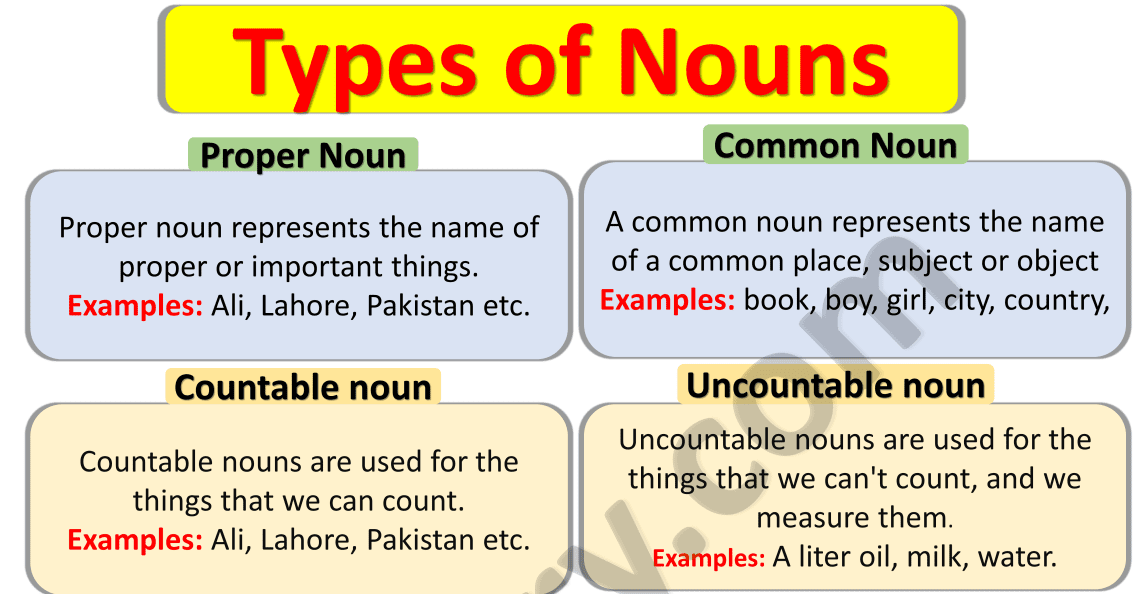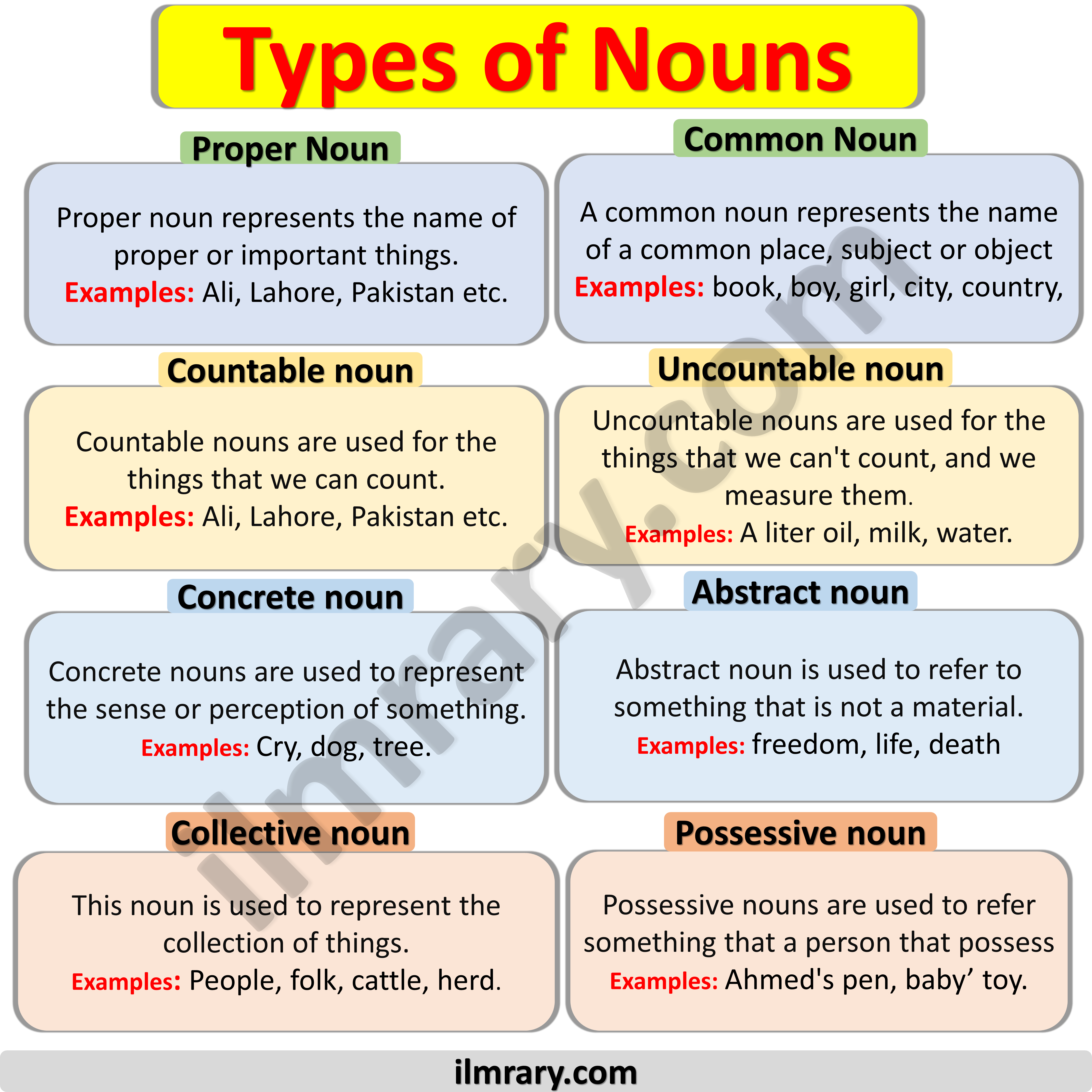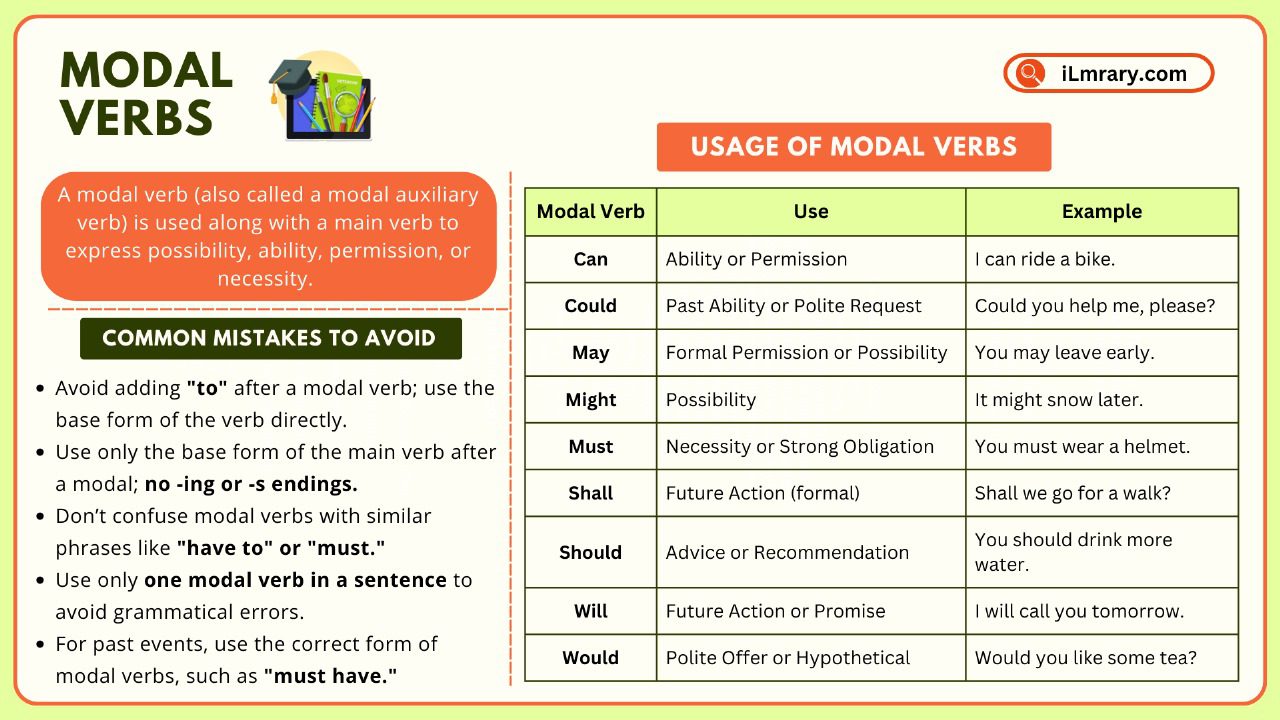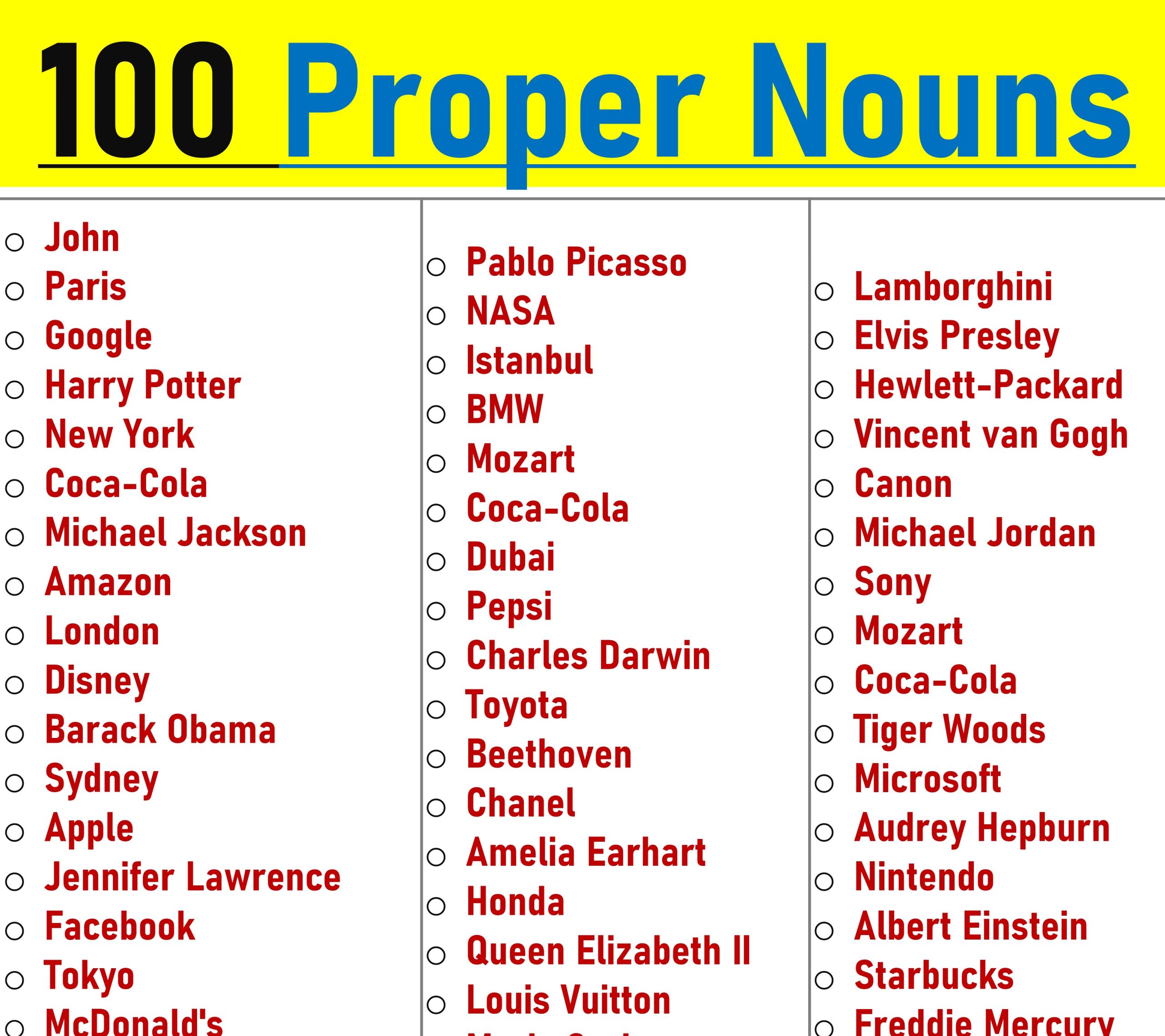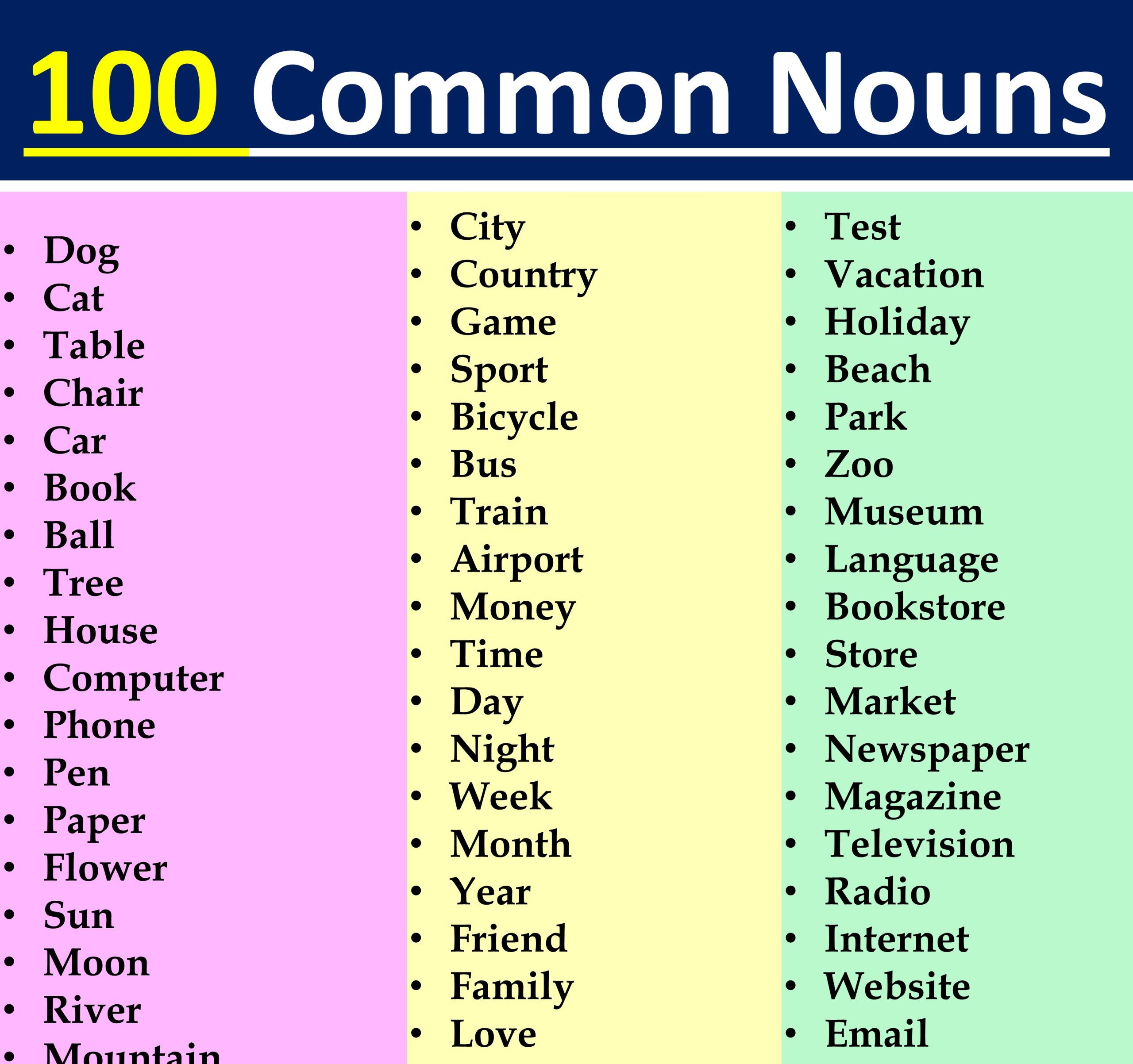Nouns are an important part of English grammar. They help us name people, places, things, and ideas. Understanding nouns and their types is essential for learning English, whether you are just starting or looking to improve your grammar. In this guide, we will explore what nouns are, the different types of nouns, and how they function in sentences. Knowing about nouns will help you create better sentences and improve your grammar skills. Let’s look at the basics of nouns and how they help us communicate clearly.
Contents
What is a Noun?
A noun is a word that names a person, place, thing, or idea. It acts as the subject or object of a sentence, helping to provide structure and meaning. Nouns are fundamental in everyday communication, as they help us talk about everything around us, both tangible and intangible.
For example
- Ali went to the park.
- The dog is playing with a ball.
In these examples, Ali, park, dog, and ball are all nouns. Ali is a person, park is a place, dog is an animal, and ball is an object.
Types of Nouns
- Common Noun
- Proper Noun
- Countable Noun
- Uncountable Noun
- Concrete Noun
- Abstract Noun
- Collective Noun
- Possessive Noun
- Compound Noun
- Gerund (Verbal Noun)
1. Common Noun
A common noun is a general name for a person, place, thing, or idea. It does not refer to a specific one, but rather to any member of a category.
Example Words:
- Boy
- City
- Car
- Animal
Example sentences:
- The dog is barking loudly.
- I saw a car parked outside.
- She has a pet animal.
2. Proper Noun
A proper noun refers to a specific person, place, thing, or idea. It is always capitalized to indicate its uniqueness.
Example Words:
- Ali
- Paris
- Mount Everest
- Pakistan
Example sentences:
- Ali is going to Lahore tomorrow.
- They visited Paris last year.
- Mount Everest is the highest mountain in the world.
4. Uncountable Noun
An uncountable noun refers to things that cannot be counted individually. These nouns typically represent substances, qualities, or concepts that are measured rather than counted.
Example Words:
- Water
- Sugar
- Money
- Air
Example sentences:
- There is water in the glass.
- He bought some sugar for the cake.
- Money is important for daily life.
In these examples, water, sugar, and money are uncountable nouns because they cannot be counted as individual units without being measured or quantified.
5. Concrete Noun
A concrete noun refers to a thing that can be perceived by the senses (touch, sight, hearing, taste, or smell). These nouns represent physical objects that you can experience directly.
Example Words:
- Book
- Dog
- Chair
- Flower
Example sentences:
- The dog is running in the park.
- She sat on the chair by the window.
- I bought a new book yesterday.
In these examples, dog, chair, and book are concrete nouns because they represent tangible objects you can see, touch, and interact with.
7. Collective Noun
A collective noun is the name of a group or collection of people, animals, or things. It refers to a single entity made up of multiple members or items.
Example Words:
- Team
- Family
- Flock
- Class
Example sentences:
- The team won the match.
- The family went on vacation.
- A flock of birds flew across the sky.
In these examples, team, family, and flock are collective nouns that refer to groups of people, family members, and birds, respectively.
8. Possessive Noun
A possessive noun shows ownership or possession. It is formed by adding an apostrophe and “s” to the noun.
Example Words:
- John’s
- The teacher’s
- Ali’s
Example sentences:
- This is Ahmed’s book.
- John’s car is parked outside.
- I borrowed the teacher’s notes.
10. Gerund (Verbal Noun)
A gerund is a noun formed from a verb by adding “-ing.” It represents an action or state as a thing or idea. Even though it is based on a verb, a gerund functions as a noun in a sentence.
Example Words:
- Reading
- Swimming
- Writing
Example sentences:
- Reading is my favorite hobby.
- I enjoy swimming in the lake.
- Writing letters to my friends is fun.
In these examples, you can see that the gerunds reading, swimming, and writing are all functioning as nouns despite being based on verbs.
Summary of Noun Types
| Noun Type | Definition | Examples |
|---|---|---|
| Common Noun | General name for a thing, person, or place. | boy, city, car |
| Proper Noun | Specific name for a person, place, or thing. | Ali, Paris, Mount Everest |
| Countable Noun | Things that can be counted. | apple, dog, book |
| Uncountable Noun | Things that cannot be counted. | water, air, sugar |
| Concrete Noun | Things that can be perceived by the senses. | dog, chair, flower |
| Abstract Noun | Ideas or concepts that cannot be touched or seen. | love, happiness, truth |
| Collective Noun | Names a group of things, people, or animals. | team, family, class |
| Possessive Noun | Shows ownership. | John’s, teacher’s, Ali’s |
| Compound Noun | Formed by combining two words to make a new noun. | toothpaste, football, sunflower |
| Gerund | A noun formed from a verb by adding “-ing”. | swimming, reading, writing |
Nouns Vs. Pronouns
| Aspect | Nouns | Pronouns |
|---|---|---|
| Definition | Words that name people, places, things, or ideas. | Words used to replace nouns in a sentence. |
| Function | Nouns give names to specific or general entities. | Pronouns make sentences shorter by replacing nouns. |
| Examples | Ali, Lahore, book, love | He, She, It, They, This |
| Usage in Sentence | Nouns act as the subject or object in a sentence. | Pronouns replace nouns that are the subject or object. |
| Gender and Number | Nouns can be masculine, feminine, or neutral and singular or plural. | Pronouns can also be masculine, feminine, neutral, singular, or plural. |
| Antecedent | A noun is the main subject or object in the sentence. | A pronoun refers back to a noun (antecedent). |
Examples to Compare Nouns and Pronouns
Noun Examples:
- Ali went to the market.
Ali is the noun; it is the subject of the sentence.
- The book is on the table.
- The book is a noun and is the subject of the sentence.
Pronoun Examples
- He went to the market.
The pronoun He replaces Ali, referring to the same person.
- It is on the table.
The pronoun It replaces the noun The book to avoid repetition.
Key Points:
- Nouns are words that name people, places, things, or ideas.
- Pronouns replace nouns in sentences, often making them shorter and avoiding repetition.
- For example, Ali is a noun, and He is the pronoun replacing Ali.
How to Recognize a Noun?
Recognizing nouns in sentences is a key skill for understanding English grammar. Here are some tips to help you identify nouns:
Nouns are words that name people, places, things, or ideas. In sentences, nouns can refer to a person (e.g., Ali), a place (e.g., Lahore), a thing (e.g., car), or an idea (e.g., freedom).
Nouns can be the subject or object of a sentence. The subject is the noun doing the action, while the object is the noun receiving the action. For example, in the sentence “Ali (subject) kicked the ball (object),” both “Ali” and “ball” are nouns.
Articles and determiners often come before nouns. Words like “a,” “an,” “the,” “my,” or “his” are usually followed by nouns. For instance, in “The dog is barking,” “dog” is the noun.
Conclusion
Nouns are crucial for constructing sentences and expressing meaning in English. Understanding the different types of nouns, such as common nouns, proper nouns, countable and uncountable nouns, and more, will greatly improve your ability to use and recognize nouns in everyday communication. By mastering nouns, you will have a stronger foundation in English grammar and be able to express yourself clearly and effectively.
Frequently Asked Questions
1. What is a noun in simple words?
A noun is a word that names a person, place, thing, or idea. For example, book, city, and happiness are all nouns. They help us identify and talk about things in the world.
2. Can you give examples of common and proper nouns?
Sure! Common nouns refer to general things, like dog and city, while proper nouns refer to specific names, like Ali and Lahore.
3. What is the difference between countable and uncountable nouns?
Countable nouns can be counted, such as apple (apples) and book (books). Uncountable nouns cannot be counted and usually refer to things like water, sugar, or knowledge.
4. What are concrete and abstract nouns?
Concrete nouns are physical things that can be seen or touched, like table or dog. Abstract nouns are ideas or concepts that can’t be touched, like love or freedom.
5. How do possessive nouns work?
A possessive noun shows ownership. You add an apostrophe and “s” to a noun to show possession, such as Ali’s book or the dog’s toy.
You May Also Like


